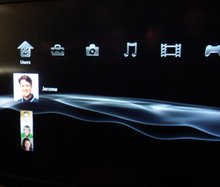The Issue: Reaching a living room TV audience has never been as easy as reaching PC-web users.
Solutions: Internet connectivity is reaching the living room TV and enabling developers to offer their own TV-web channel to anyone interested.
Behind the scene: Active-TV technology now makes it relatively easy for someone with HTML and Java Script skills to construct a TV channel. It is not any more difficult than constructing a PC-web page.
The popularity of YouTube and other video sharing websites makes it easy to share video with other PC users. Now, with active-TV technology reaching TVs and networked Set-Top Boxes (STB) in the living room, and utilizing the YouTube API interface, it is easy to build a TV-formatted video-channel for living room viewing. Let’s see how this is accomplished.
TV-formatted web, or TV-web, is much like PC-web, except interaction is via an Infra-Red (IR) remote and not a keyboard and mouse. A TV UI is also much simpler, making use of larger clearer images and not making much use of text. Microsoft provides suggested guidelines and example TV-web layouts. Microsoft also provides tool plug-ins for FrontPage (its webpage development tool) which simplifies development of TV-web. There is also an updated Microsoft Vista-compatible version of the development tools, which includes support for MCML as well as HTML formatting; but use of MCML will limit the number of TVs which can view the TV-web channel.
There are no strict requirements to use the Microsoft tools or even follow its guidelines. Other HTML development tools can be used. With the availability of active-TV technology, there are few restrictions regarding what Windows operating systems is used: a Media Center Edition (MCE) PC, a Windows XP PC, or a Windows Vista PC, will all do. Note that during the introduction of the MCE PC, Microsoft used the term “MCE Application” for HTML formatted TV-web.
There is also more information about building TV-web at the Microsoft supported Sandbox blog, or at the The Green Button information-share site. MediaMall has also provided the HTML source file for its YouTube TV-web channel, which enables access to YouTube, with alternative support for Veoh and Vmix favorites. The MediaMall example does not rely on HMTL alone, but also uses Adobe Flash to deal with the TV UI layout. Active-TV platforms support the use of Adobe Flash.
One of the simplest ways to build a TV-web channel is to utilize YouTube for video distribution. Video can first be uploaded to YouTube and then retrieved by embedding the associated video tag, or embedded URL, into the TV-web Page. In leveraging YouTube in this way, only the TV-web pages need be provided by some 3rd-party server which is also accessible via the internet.
Without going through the process of first up-loading video to a server, let’s look at building a TV-web channel relating to the 2008 US Presidential Election. Relevant YouTube video can be found by entering appropriate search-words at the YouTube PC-web UI. However, YouTube also offers a search service via a REST request; know as the YouTube developer API. This consists of sending a URL-string to a YouTube HTTP server. The URL-string contains the search-tags used to match video held in the database. The request takes the form shown below.
http://www.youtube.com/api2_restapi_parameter1=value1&api_parameter2=value2&api_parameterN=valueN
http://www.youtube.com/api2_restmethod=youtube.videos.list_by_category_and_tag&dev_id=xxxxxxxxxxx&category_id=25&tag=hillary&tag=clinton
YouTube offers several ways to format a request for a search of its video library. The above example uses the “category method”, where category parameter 25 identifies “News & Politics”. With a successful REST request, YouTube returns a file in XML format. Below is an example.
- <ut_response status="ok">
- <video_list>
<total>8576</total>
- <video>
<author>ParkRidge47</author>
<id>6h3G-lMZxjo</id>
<title>Vote Different</title>
<length_seconds>74</length_seconds>
<rating_avg>4.17</rating_avg>
<rating_count>7212</rating_count>
<description>Make up your own mind. Decide for yourself who should be our next president. NOTE: This is a mashup of the famous Apple 1984 Super Bowl ad. Search for the original on YouTube.</description>
<view_count>3676321</view_count>
<upload_time>1173116996</upload_time>
<comment_count>12078</comment_count>
<tags>Hillary Clinton Barack Obama 1984 Apple Macintosh Ingsoc</tags>
<url>http://www.youtube.com/?v=6h3G-lMZxjo</url>
<thumbnail_url>http://img.youtube.com/vi/6h3G-lMZxjo/default.jpg</thumbnail_url>
<embed_status>ok</embed_status>
</video>
- <video>
<author>tpmtv</author>
<id>9BEPcJlz2wE</id>
<title>Hillary Clinton Sopranos Parody</title>
<length_seconds>95</length_seconds>
<rating_avg>3.55</rating_avg>
<rating_count>847</rating_count>
<description>Hillary, Bill, and Chelsea's car are "The Clintons"</description>
<view_count>289202</view_count>
<upload_time>1182266618</upload_time>
<comment_count>1143</comment_count>
<tags>Hillary Clinton Pres' 08</tags>
<url>http://www.youtube.com/?v=9BEPcJlz2wE</url>
<thumbnail_url>http://img.youtube.com/vi/9BEPcJlz2wE/default.jpg</thumbnail_url>
<embed_status>ok</embed_status>
</video>
- <video>
. . .
Typically, a TV-web page uses Java script to construct the URL-string for the REST-formatted search. Then the TV-web page uses more Java script to parse the returned XML file in search of interesting videos. Data such as the <title> or <thumbnail_url> image are extracted from the XML file and positioned on the TV screen layout, as shown below. The URL address for the video which is to appear on the TV must be passed to the TV-client. Remember to use the MediaCenter.PlayMedia(mediaType, mediaURL) method for this task. The steps used to add a new TV-web channel to the channel listings has been covered in prior blog entries.

The above example was selected for illustration purposes only. A developer can easily make changes to construct their own TV-web channel on some other topic. The availability of active-TV enabled boxes such as the recently upgraded D-Link DSM-520, and others entering the market shortly, make it increasingly easy to reach a living room TV audience.
In short, it is relatively easy for someone with HTML and Java Script skills to construct a TV channel. It is not any more difficult than constructing a PC-web page. At one time building a blog required HTML authoring skills, but this has been eliminated with the introduction of pre-formatted bloging tools – such as Blogger. In time, TV-web layout productivity tools will make the process of formatting a TV-web channel as easy as building a blog.
Feedback, corrections and comments welcome. Contact me for more information or support with active-TV technology development.
Daniel Mann













